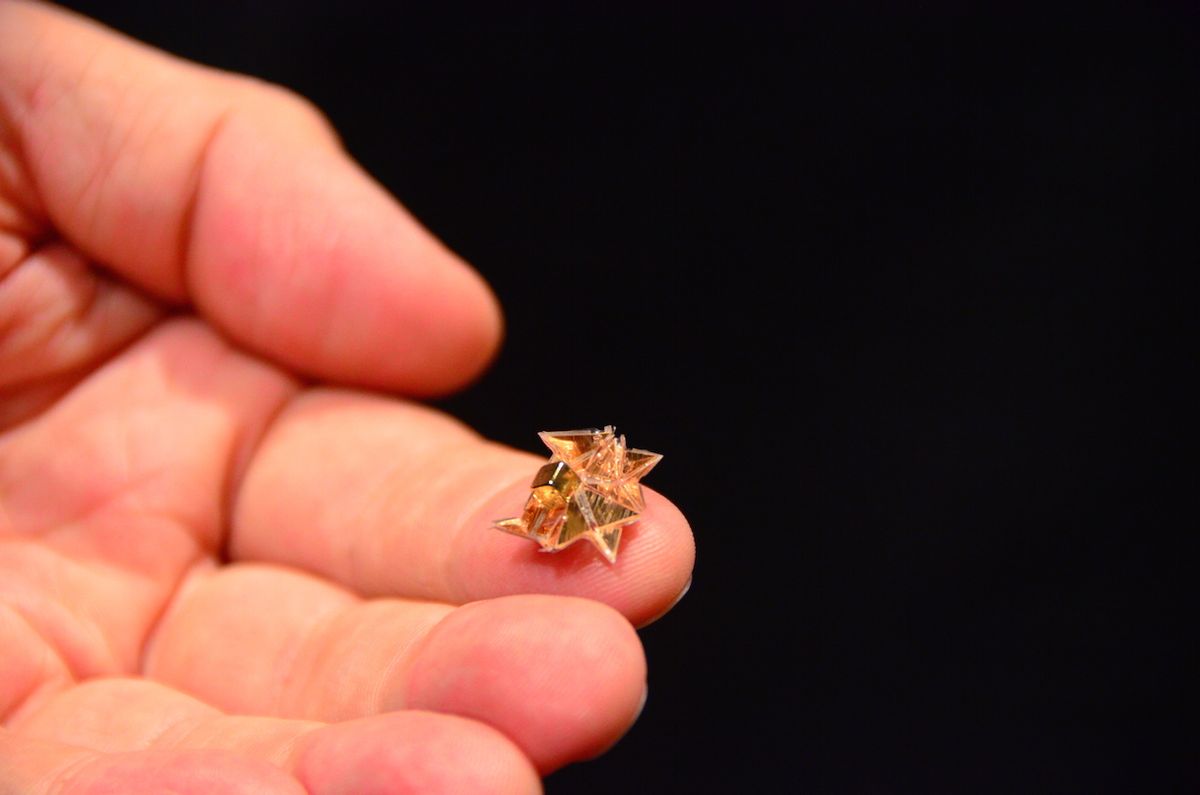At ICRA 2015 in Seattle yesterday, researchers from MIT demonstrated an untethered miniature origami robot that self-folds, walks, swims, and degrades. That’s the title of their paper, in fact, and they delivered on all of those promises: from a flat sheet with a magnet on it, their robot folds itself up in just a few seconds, is immediately ready to zip around on land or water driven by magnetic fields, and then when you’ve run out of things to do with it, drive it into a tank of acetone and it’ll dissolve. This is the first time that a robot has been able to demonstrate a complete life cycle like this, and eventually, it’ll be doing it inside your body.
The unfolded robot, which is made of a magnet and PVC sandwiched between laser-cut structural layers (polystyrene or paper), weighs just 0.31 g and measures 1.7 cm on a side. Once placed on a heating element, the PVC contracts, and where the structural layers have been cut, it creates folds.

In under a minute, the robot is finished, and is ready to go, zipping around at speeds of between 3 and 4 cm/s.

A caveat to all of this is that the “motor” of the robot isn’t really integrated into the whole self-folding and dissolving thing. The motor comes in two parts: a cubic neodymium permanent magnet that the robot folds itself around, and then a set of four electromagnetic coils underneath the surface that the robot operates on to provide the magnetic fields that drive it [right].
You might be wondering at this point why the folding robot is even necessary if you’ve got a magnetic field and you can just drag the magnet around with that, and there’s a good answer. First, the magnetic field isn’t dragging the magnet anywhere: the field is directional, but it’s just turning on and off at about 15 Hz. This causes the magnet that the robot is attached to oscillate back and forth, and the robot oscillates as well. As this happens, the front and back legs of the robot alternately contact the ground, and the asymmetry of the design combined with the intentionally off-center balance point causes the robot to walk forward. None of this works with the robot in its unfolded, flat configuration: it has to be folded into this shape to walk at all.
The other advantages of using a folded robot instead of just a magnet include the ability to float, as well as the ability to more efficiently perform tasks like moving objects or digging. And this isn’t the only design that you can use, of course: you can optimize for whatever task you’re trying to accomplish. This particular one is more of a generalist. If you want to get really fancy, you could also make the folding process multi-stage: low heat gets you one design, and then coming back to the heating pad and turning up the heat could result in a second folding stage resulting in a different design.
Once you’re done messing around, you can drive the robot into a tank of acetone and it will entirely dissolve (except for the magnet). It’s also possible to make the structural layer of the robot out of a material that dissolves in water. Making the entire robot dissolve in water is a bit trickier, but the researchers seem confident that it’ll be possible in the near future. Also possible in the near future will be integrating self-folding sensors into the body of the robot, which could lead to autonomous operation, and eventually, doing all of this inside your body.
“An Untethered Miniature Origami Robot That Self-folds, Walks, Swims, and Degrades,” by Shuhei Miyashita, Steven Guitron, Marvin Ludersdorfer, Cynthia R. Sung, and Daniela Rus from MIT and TU Munich, was presented yesterday at ICRA 2015 in Seattle.
Evan Ackerman is a senior editor at IEEE Spectrum. Since 2007, he has written over 6,000 articles on robotics and technology. He has a degree in Martian geology and is excellent at playing bagpipes.



